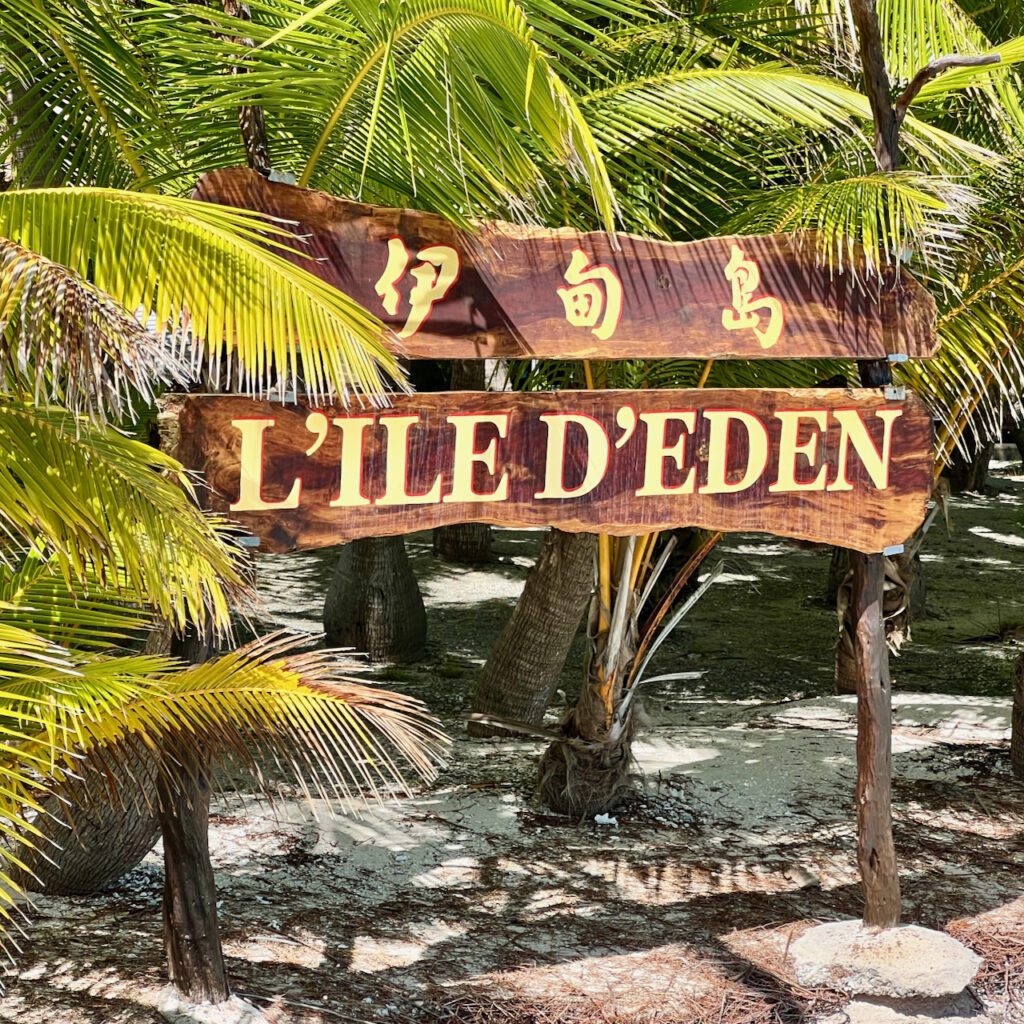
A colleague at a startup where I once worked remarked that it would be better to start a religion than a company. His theory was that we’d have more loyal customers, better product-market fit, better tax benefits, and a faster path to profitability. Actress Mui Lee might have agreed when she founded the New Testament Church in Hong Kong in 1963.
The church has many locations today, including this one: a small island in the Tikehau Atoll, Tuamotus, French Polynesia, where we are now. The locals call it Motu Ohihi. The island residents call it L’Île d’Eden or Eden Island, as in “Garden of Eden.”
Two families operate the organic farm on the island. They are almost entirely self-sufficient. They grow vegetables and fruit, raise pigs and chickens, distill sea salt, culture pearls, and collect rainwater. They are strongly committed to organic and natural farming practices inspired by the Bible’s Garden of Eden. It works for them.
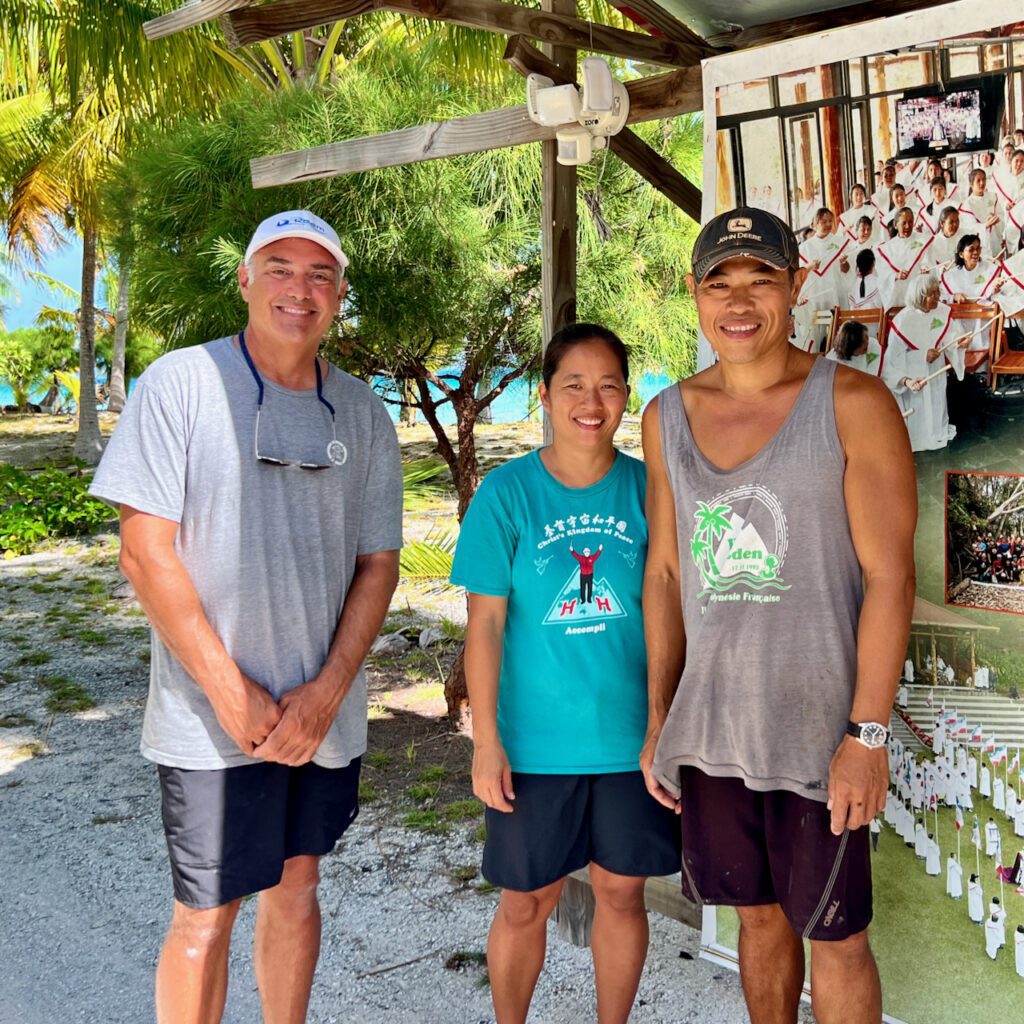
We spent nearly two hours touring L’Isle d’Eden’s farm with Paul and Sheila. Paul has lived here since 1997. We saw their organic farming practices in action. They take it seriously and are quite proud of what they produce and how they produce it. They were very patient with our questions about the church, its doctrine, and its organization. We left with a big bag of fresh greens for 1,000 French Polynesia Francs (about $10 USD).
Before COVID, the families would often sell their surplus at the market in the town at the other end of the lagoon. COVID changed that. Now, most of their trading is with cruising sailboats that come to visit. The maramu winds often bring the boats here. Paul seemed happy to have boats anchored off their island.
The church is headquartered in Taiwan and has locations worldwide, including Tahiti, Africa, Malaysia, and even Paso Robles in California. If you’ve been to the farmers market in Paso Robles, you may have seen the Mt. Olive brand there. Each location specializes in some form of agriculture. When logistically possible, the church locations trade with each other.
The church is not without controversy. They’ve been labeled a “heterodox” (cult) by the Chinese government. However, their farming practices have been frequently studied and replicated, and you can appreciate the peaceful home they’ve created for themselves.
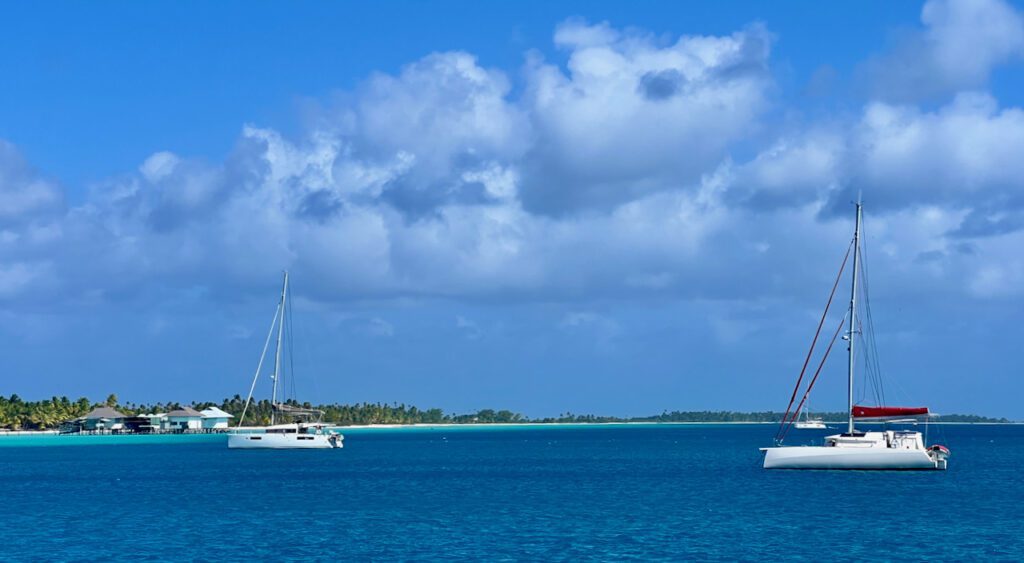
We are anchored off their island, waiting out a 10-day “maramu.” Maramu is Polynesian for a strong southeasterly wind. It’s caused by a high-pressure zone in the southern ocean smashing up against the low-pressure zone to the north. This is often called a “squash zone” as the isobars get squeezed together, accelerating the trade winds and the associated seas. While it can also generate squally weather, we mainly deal with strong 25 – 35 knot winds. We could sail in this. It wouldn’t be fun.
We arrived almost a week ago from Rangirora. Our friends Jim and Angela from California spent a few days with us in Rangiroa and on the sail to Tikehau. They started their vacation on Bora Bora and are now finishing up on Moorea, places we hope to visit soon ourselves. It was great having them aboard.
This is the calmest spot in the lagoon. We’re hunkered down with six other boats. It’s beautiful: a white-sand beach with palm trees, nice walks, and a smooth place to paddle board. Our neighbors have been kite surfing and wing foiling.
We want to get moving again and head to Tahiti. But it’s not worth getting banged around in 10 to 12-foot seas on a blustery beam reach, so we will wait a bit longer. There are definitely worse places to be.


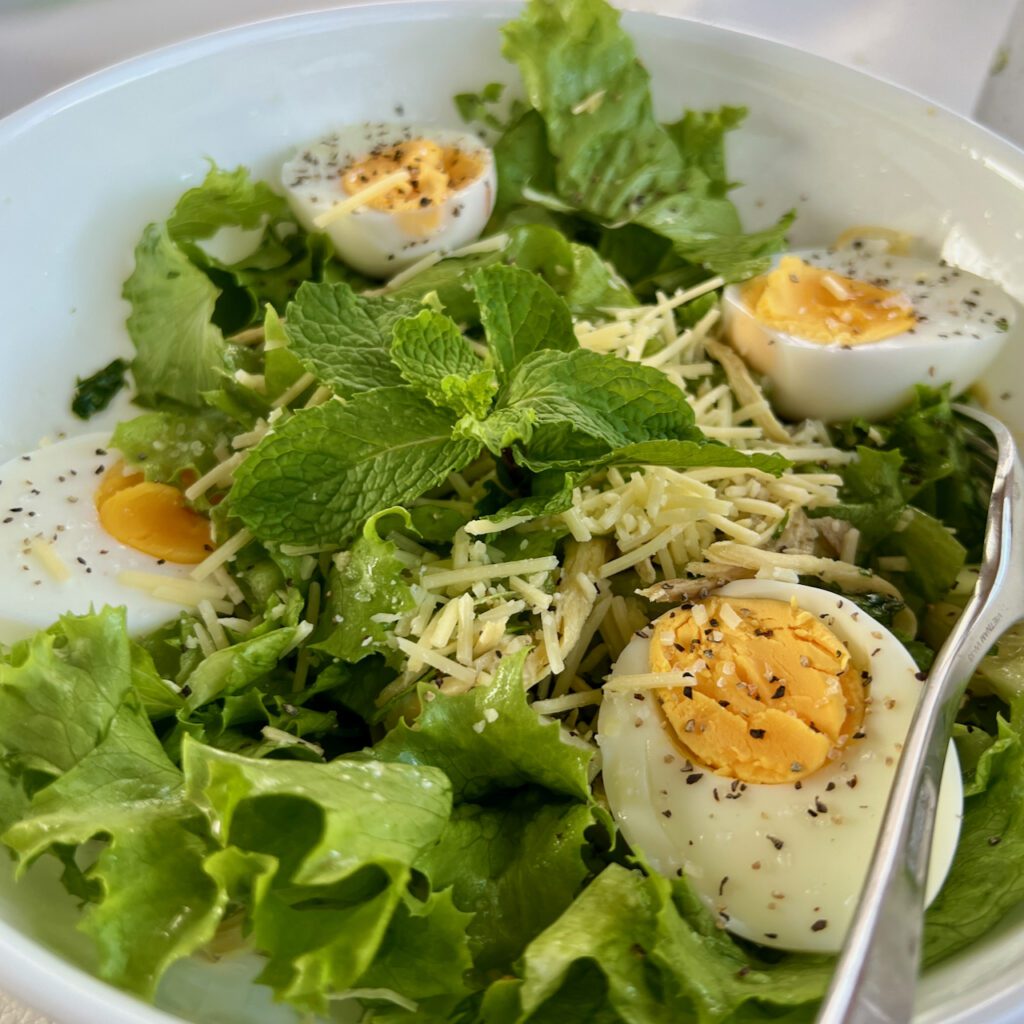

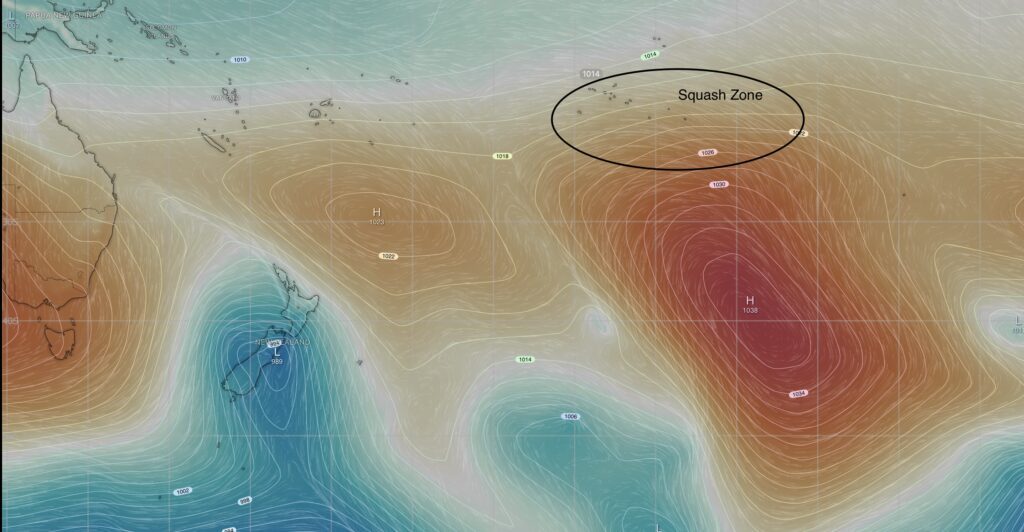
Updates from our PredictWind log:
Toau – Passe’ Otugi
Sun Jun 16 2024 15:37:00 GMT-1000 (Tahiti Time)
15 57.500s 145 52.087w
All is well. We are presently moored in the southeast corner of Toau atoll, Tuamotus archipelago, French Polynesia.
We had a delightful two hour spinnaker run from Fakarava in 15 knots of breeze and 4’-6’ quartering seas. We flew symantha the Symmetrical spinnaker with no main and 1/3 daggers.
We left Fakarava through the North Pass at slack tide. We dodged a few dive boats on the way out.
We entered through Toau’s Passe’ Otugi about an hour into the ebb tide. This pass has a reputation for being difficult. It was a bit sporty with 3’ standing waves on the north side and a 3 knot ebb current. But we found it manageable.
It was a short motor through scattered coral bommies to the southeast corner. The government has thoughtfully installed 7 new mooring balls here. This saves us the effort of anchoring and it saves the bottom from damage from anchors. A win/win. This is our first mooring since a year ago in Banderas Bay, Mexico. Pam snagged it on the first try.
It’s quiet and beautiful with a long, white sand beach covered in palm trees.
We will be here for a day two as we island hop our way up to Rangiroa.
Happy Fathers Day. My first without mine.
—Jim

Toau Anse Amyot
Wed Jun 19 2024 12:16:00 GMT-1000 (Tahiti Time)
15 48.197s 146 09.152w
All is well. We are presently moored in Anse Amyot (aka the False Pass) on the northeast corner of Toau atoll.
We are on a mooring ball thoughtfully provided by the French Polynesian government and tended to by the nearby local residents, Gaston and Valentine. They live on the island with their family.
We had a delightful 3 hour spinnaker run under Samantha our symmetrical spinnaker. Spinnaker only, no main.
The trip was only marred by me crashing the drone while trying to land it on the solar panels on the stern where it promptly bounced into the ocean. Ocean = 1, drone = 0. It was a pretty cool video of us under sail. You’ll have to trust me on that.
We will hang out here and do some snorkeling in the nearby coral gardens. We plan to leave tomorrow afternoon for the overnight sail to Rangiroa.
—Jim

Toau to Rangiroa
Fri Jun 21 2024 09:30:00 GMT-1000 (Tahiti Time)
14 58.113s 147 38.164w
la Ora na! We are anchored inside Tipiuta Pass, Rangiroa atoll, Tuamotus, French Polynesia.
We enjoyed a fast 17 hour overnight reach under a bright full moon with 10-15 knot east northeasterlies and moderate seas. We started out with Jack and Jill wing on wing and then shifted gears to a reefed main and Jack sheeted to the chain plate on the rail. We made better time than expected and had to slow down for the last 30 miles under Solent alone.
Típuta pass was forecast for low slack tide at 8:39 am. We entered at 8:30 with a 6 knot ebb current and 3’ standing waves. It was manageable but it tells you how much water the wind has pushed over the reefs into the lagoon lately. Tiputa’s famous dolphins escorted us through the pass. A nice welcome.
We will be here for the better part of this week. Our friends from the US Jim and Angela arrive on Sunday and will stay aboard with us for several days as we dive and explore this atoll and next door Tikehau.
Time for a hot shower and a nap.
—jim

Tikehau Tuheiava Pass
Tue Jun 25 2024 12:54:00 GMT-1000 (Tahiti Time)
15 00.365s 148 16.312w
All is well. We are presently anchored near the Tuheiava pass into Tikehau lagoon after a brilliant spinnaker run from Rangiroa.
We departed the northern pass (Passe D’Avatoru) at Rangiroa at high slack with about 1-2 knots of flood current.
Once outside we hoisted Samantha the Symmetrical spinnaker and ran deep angles at 8-10 knots all the way around the northern sides of Rangiroa and Tikehau.
Entering the lone pass at Tikehau an hour after rangioa’s low slack (no tide predictions for Tikehau) we still had 5-6 knots of ebb current pushing against us. Standing waves on the south side of the pass.
We are here for some snorkeling starting with the pass after lunch today.
Then we need find a snug spot on the east side of the lagoon to shelter from the strong easterlies forecast for the next week or so.
—Jim
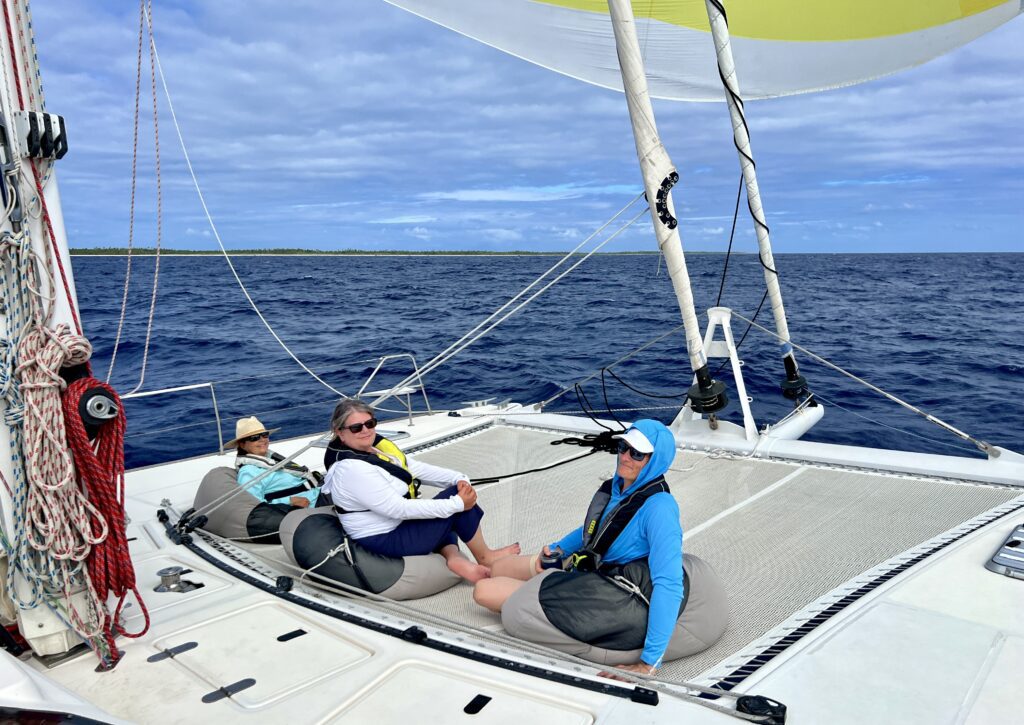
Tikehau Motu Tavaniatea
Tue Jun 25 2024 18:30:00 GMT-1000 (Tahiti Time)
15 05.525s 148 11.164w
All is well. We are presently anchored in 15’ of water over a sandy bottom in a nook against Motu Tavaniatea on the south side of the Tikehau lagoon. We motored over here with the last of the sunlight against our backs to be in a better spot for the increasing easterlies. They are forecast to blow for the next week or so.
Snorkeling the pass wasn’t great. We never got a flood current and the drift diving the pass on the outgoing ebb current is always risky. We settled for one trip through it and then tried a few of the reefs around our anchorage.
We’ll be exploring the southeast side of the lagoon for the next few days.
–Jim
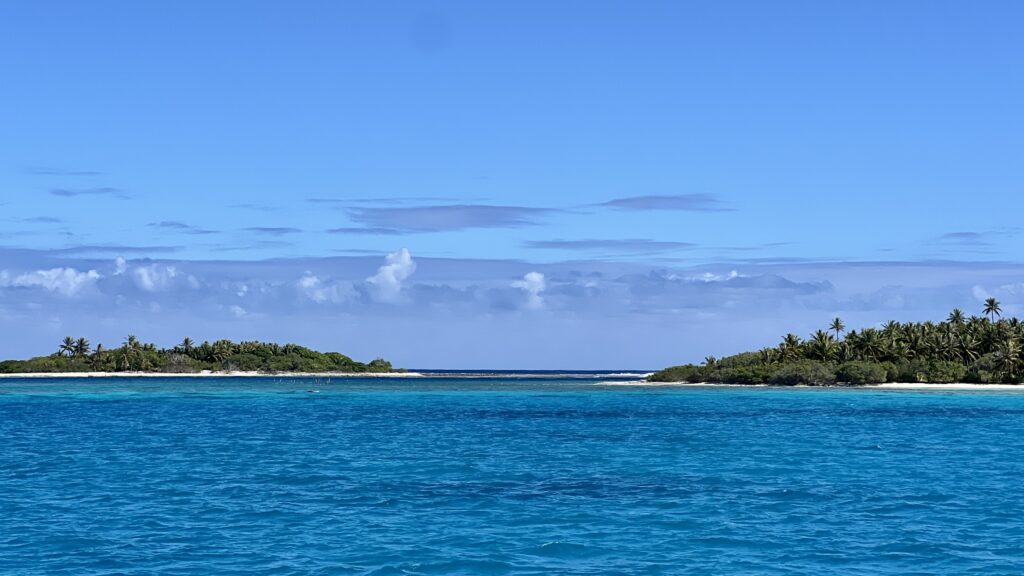
Motu Mauu
Wed Jun 26 2024 20:19:00 GMT-1000 (Tahiti Time)
15 06.662s 148 12.913w
All is well. We are once again snuggled up against the east side of Tikehau waiting for this maramu to blow itself out. This time next to Motu Ohotu.
We motored over to Motu Mauu in the middle of the lagoon. It’s known for having a manta ray “cleaning station” where the manta rays congregate to have the wrasses pick the parasites off of them. It was quite an ordeal to get anchored there in 15-20 knots of wind on an exposed island. We were able to nudge our nose almost onto the island and drop the anchor in about 20’ of water before the wind blew us back and over about 60’.
We took the dingy a short way and tied it to one of the tour boat moorings. Then we snorkeled over the reef to where the manta ray’s reportedly hang out. But they were not home. Maybe it’s like home. They only have time to get cleaned during their lunch break or after work. The local dive shop said it was too rough for them. Smart rays. Smarter than us.
After lunch we went looking for respite from the increasing wind and wound up back up against the east shore. Still quite a bit of wind chop here though.
Tomorrow we will motor north up to the “garden of Eden.” It should be smoother up there. We will see. The wind is forecast to peak at gusts in the mid 30 knot range – for the next week. Woo hoo! Paradise!
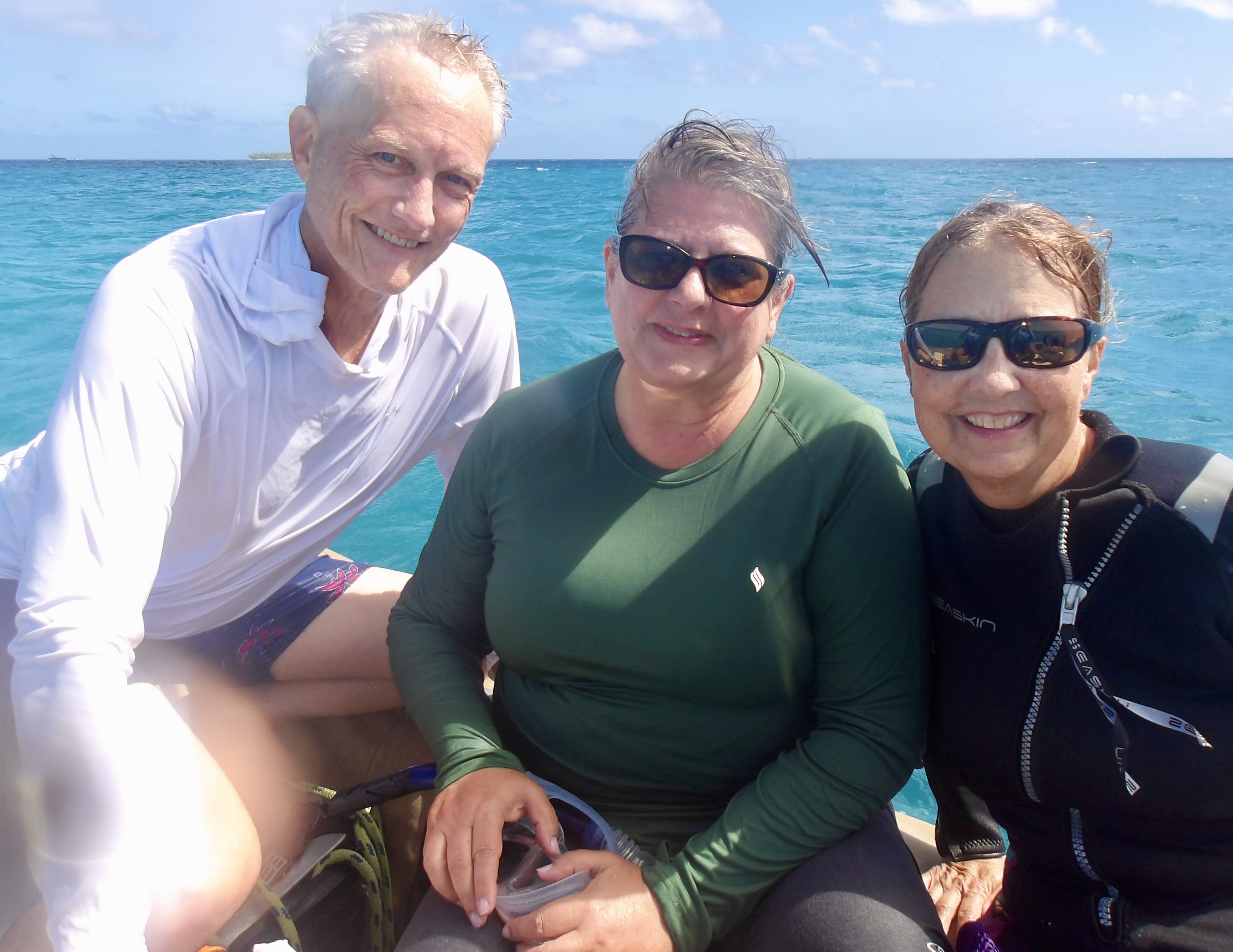

L’Ile D’Eden
Thu Jun 27 2024 15:07:00 GMT-1000 (Tahiti Time)
15 00.013s 148 03.318w
All is well. We are presently anchored at the “Garden of Eden” on the northeast corner of the Tikehau lagoon. We motored up here from the town quay to escape the howling maramu winds that continue to blow through the Tuamotus.
It was a bit of a bouncy night last night down on the eastern shore. The winds have put a damper on things here. Our friends Jim and Angela decided to call it early and head for Moorea. Can’t blame them. If you aren’t used to this it can be a bit unnerving.
We motored over to the town quay this morning and anchored behind the breakwater. With some effort we were able to get them safely on the dock and into the hands of the dive shop guys who will take them to the airport. All of their dive trips are canceled for the next several days so they are happy to have the shuttle fare.
Once we had the anchor up we headed north for calmer water and found it here. Flat calm with some shelter behind the trees.
The organic farm here is run by two families. We will visit them tomorrow and see about getting some fresh vegetables.
This maramu looks like it will peak on Saturday and finally start to subside on Tuesday. We will likely be here until then.
—Jim
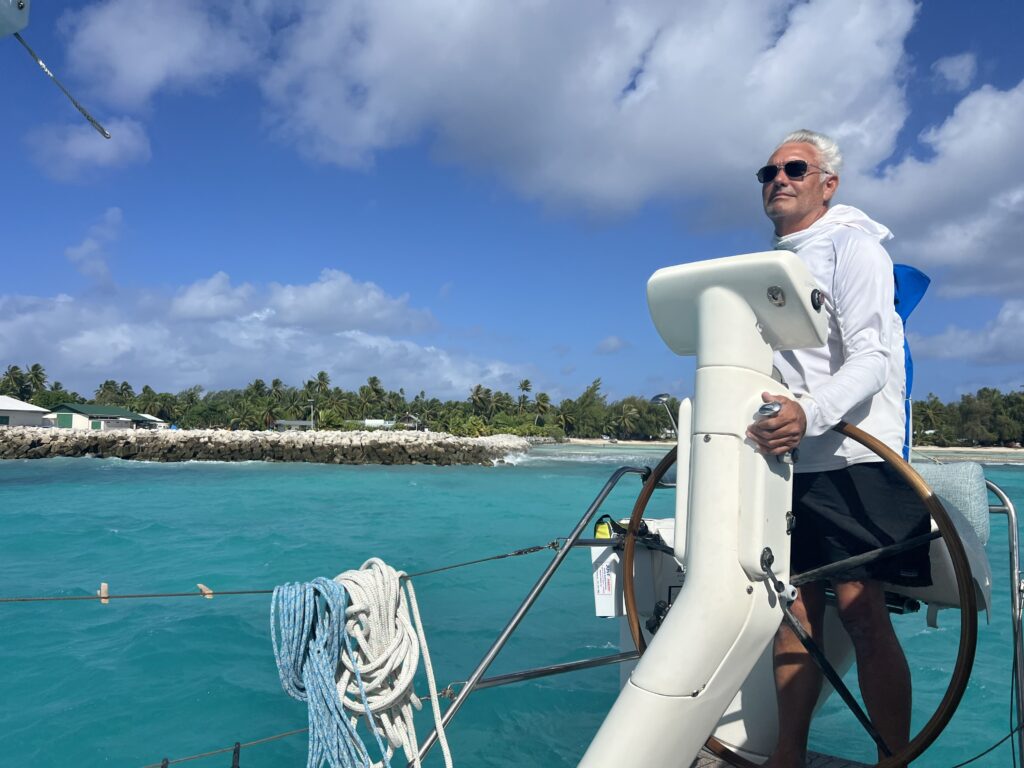

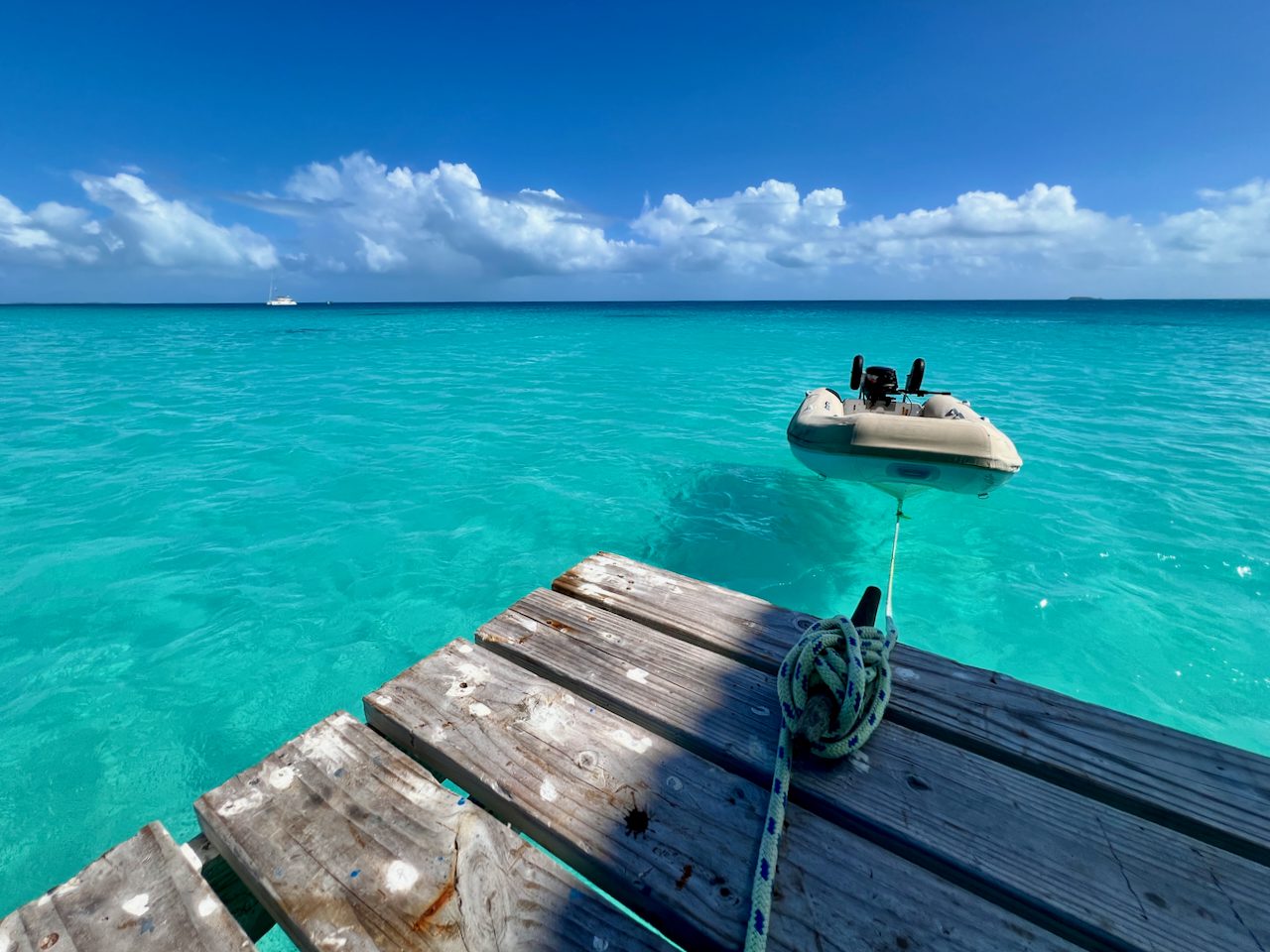
Love all your commentary. Brings back so many wonderful memories. Thanks. Do t forget to buy some pearls. 😉
Boy do I remember the squash zones. I was doing the weather back then. Don’t miss those. Glad you are getting to see so many atolls. Very special places. We loved all of French Polenesia. Enjoy and safe smooth sailing.
You had it much harder back then than we do now. Weather information was much harder to get when you were here. You probably started with analog weather fax via HF radio and later graduated to GRIB files over sailmail via HF radio. You might have had text or voice weather forecasts — probably in French.
Today we have it easy. First, we have unlimited high speed internet everywhere (bless you SpaceX and Starlink). Second we have these amazing numerical weather models that run twice a day — ECMWF, GFS, UKMO, SPIRE. Third, we have software that analyzes and visualizes these weather models.
PredictWind is our go-to weather briefing every day. In addition to visually presenting the weather models, it does an incredible job of routing us from one place to another, optimizing our route for speed and comfort. It can also tell us the best day to leave, and how long it will take to get where we are going. We upload our actual performance data as we are sailing to their AI engine in the cloud and it figures out how we sail our boat. The software uses that custom, actual “polar” data when it makes routing recommendations for future passages. I can’t say enough good things about what these software gurus in New Zealand have done with this product.
We also use Windy which is a great, free or inexpensive app for viewing weather models.
None of these tools changes the behavior of the squash zones and their respective reinforced trade winds. But we are never surprised by them.
Here is a snapshot of what our PredictWind routing has to say about the run we’re planning to make this evening from Makatea to Moorea.

On the quest for Tahitian black pearls. I find the collapse of the Tahitian cultured pearl industry fascinating. Most lagoons in the Tuamotus are littered with abandoned pearl farms. These are vast rope webs that sit just below the surface sometimes marked by small pearl floats on the surface. They aren’t charted very well, and you can’t see them in the sat photos. I notice them about the time we sail into a bunch of them. Fortunately, we typically run a shallow draft configuration and haven’t snagged them. It’s unnerving.
While on Rangiroa a few weeks ago, we finally made it to a pearl operation for an in-depth tour. It was very interesting. The tour goes into great detail and lets you see the operation firsthand. They do this partly to help you understand why they are trying to charge the prices they charge for cultured pearls.
The industry has collapsed for all practical purposes. It is very capital-intensive (as far as French Polynesia). To make it work financially, you need volume, consistant quality, and high prices. None of which is easy to achieve with luxury goods where consumer preference is fickle.
Talking to different people involved in pearl farming, I learned a few things about what happened to their industry over the past few decades:
1. A flood of product — nearly every atoll tried to get in on the action
2. No control over quality — the quality of pearls varied widely
3. No unified marketing message or branding
4. Ultimately, there is no central body to police price, volume, and quality. There is nothing like De Beers in the diamond industry, which heavily markets the idea of a diamond’s value and controls the supply, quality, and price.
You never know, though. Tahitian pearls may be one TikTok meme away from a resurgence in popularity.
Here is the technician at work at the Paul Gaugin Pearl Farm on Rangiroa. He’s inserting a “nucleus” and a small speck of “mantle” that the oyster will hopefully coat with a beautiful layer over the next two years. The nucleus is a marble-sized ball made from the shells of gulf coast oysters. The mantle is taken from oyster shells that have the desired color and pattern.
